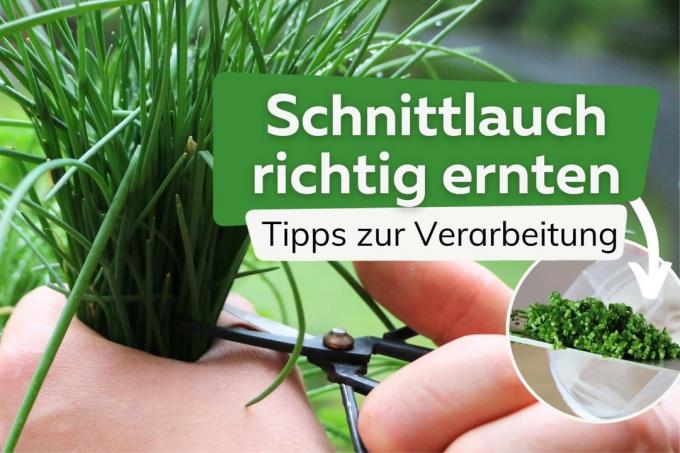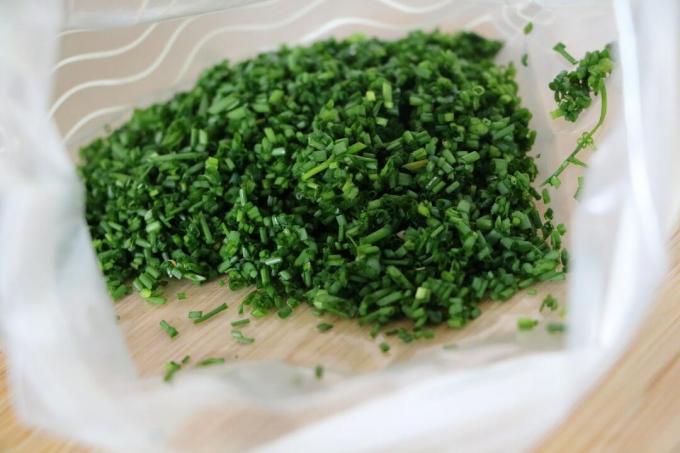
Harvest and process chives properly! So that the aroma of the green tubes is particularly leek-spicy on the palate. We give you tips on how best to proceed.
In a nutshell
- Harvest time from March before flowering, indoors all year round
- harvest on a dry, warm day in the late morning
- to do this, cut off 2 to 3 cm above the ground
- Consume fresh or place in a glass of water for 2-3 days
- various methods of preservation: freezing, salting, pickling in oil or vinegar, preparing pesto
Table of contents
- harvest season
- harvest time
- Harvest right
- Use straws fresh
- preserve chives
- Freeze
- Preserve with salt
- Prepare pesto
- Preserve in oil or vinegar
- frequently asked Questions
harvest season
In the garden, the season for chives is limited to the warm months of the year due to the weather. Did you sow the herb early? or is there already a plant from the previous year in the garden bed? Then you can usually harvest chives for the first time in March and then process them. However, the stalks should be at least reached 15 cm in length. Harvest time lasts so long
until the flowers appear. After that, the green no longer tastes good. On a bright, sunny windowsill Chives can usually thrive well and provide a few green stalks for harvesting even in winter.
Tip: Fortunately, the flowering time of chives can be influenced. Just keep removing any flower buds that show up. This allows you to extend the harvest time by many weeks.
harvest time
The aromatic substance content of the stalks fluctuates throughout the day and also depends on the weather. They taste best if you pick the right time to harvest:
- dry and warm day
- In the late afternoon
- before the midday heat
Harvest right

You can harvest chives almost every day, whenever you need the herb. This applies to the cutting the following rules:
- only harvest for current needs
- use a sharp knife or secateurs
- handle carefully, do not crush the stalks
- Cut about 2 to 3 cm above the ground
- Cut already divided stalks over the fork
- Cut off the outer stalks first
Tip:So that the plant grows vigorously and vigorously, you should also cut them back harder from time to time.
Use straws fresh
Chives taste best fresh and raw. If you cannot use it up shortly after harvesting, you should store it optimally immediately.

Place the straws in a jar, glass or cup filled with water. The cut ends should be 2 to 3 cm in the water. On very warm days you may have to To refill water. Alternatively, wrap the straws in a damp tea towel or kitchen paper and place them in the fridge.
preserve chives
once cut off, the stalks quickly turn yellow and dry. We share tips on how to keep chives lasting longer by processing them in one of the following ways after harvesting.
Freeze
A large amount of unused chives remains, especially after vigorous pruning. Don't throw away the tubes, they freeze well for a winter supply.
- Wash straws thoroughly
- Discard yellow, damaged stems
- allow to dry completely or pat dry
- Cut into small rolls with sharp scissors
- portion and pack airtight in sealable containers or freezer bags

Frozen chives will keep for about six months. You don't have to thaw it before using it, it can go straight from the freezer into the saucepan.
Tip: Refrain from drying chives. Because the dried pieces will taste more like hay than the spicy leek, as hoped.
Preserve with salt
You can also preserve the washed and dried chive stalks with salt so that you can use them later for quark, soups or soups, for example. Here's how to do it:
- sterilize a jar
- Cut the chives into very fine rings
- Provide two teaspoons of salt for every 100 grams of chives
- layer alternately in the glass
- press firmly with a pestle
- Store in the sealed jar in the fridge
- use within four months
- remove with a clean spoon
Tip: If you want the chives to last longer, increase the amount of salt up to 20% of the amount of chives.
Prepare pesto

There are plenty of pesto recipes online. Choose your favorite recipe and replace the green used with chives. If you are concerned that the leeks will taste too dominant, you can use chives along with other green herbs. Poured into a clean screw-top jar and covered with a little oil, the pesto will keep in the fridge for several weeks.
Preserve in oil or vinegar
You can experiment with these two types of preservation. It is important that the chives dry well after harvesting and before use and that they are always completely cleaned of vinegar or vinegar afterwards. is covered. Which vinegar and which oil you use is up to your taste. You can also add some dry spices like peppercorns or chili add to. The chive vinegar should be stored in the refrigerator, the oil should be dark and dry.
frequently asked Questions
If the chive plant is already in bloom, you should not harvest any more stalks. They are firm and fibrous and have acquired a bitter taste.
If you plant the chives about 2 to 3 cm above the ground or cut above the branch will automatically sprout new culms.
Do not plant chives with cabbage, broccoli, peas, beans, beetroot, garden cress or cilantro. These growths will have a negative impact on the health and growth of the leek.
Yes, the flowers are edible and at the same time a pretty decoration. They have a slight sharpness, which is accompanied by a subtle sweetness.



